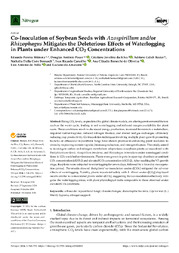Co-Inoculation of Soybean Seeds with Azospirillum and/or Rhizophagus Mitigates the Deleterious Effects of Waterlogging in Plants under Enhanced CO2 Concentrations
Co-Inoculation of Soybean Seeds with Azospirillum and/or Rhizophagus Mitigates the Deleterious Effects of Waterlogging in Plants under Enhanced CO2 Concentrations
Author(s): SHIMOIA, E. P.; POSSO, D. A.; DA-SILVA, C. J.; BESTER, A. U.; BERNARDI, N. D. C.; CARVALHO, I. R.; OLIVEIRA, A. C. B. de; AVILA, L. A. de; AMARANTE, L. do
Summary: Abstract: Rising CO2 levels, as predicted by global climate models, are altering environmental factors such as the water cycle, leading to soil waterlogging and reduced oxygen availability for plant roots. These conditions result in decreased energy production, increased fermentative metabolism, impaired nutrient uptake, reduced nitrogen fixation, and altered leaf gas exchanges, ultimately reducing crop productivity. Co-inoculation techniques involving multiple plant growth-promoting bacteria or arbuscular mycorrhizal fungi have shown promise in enhancing plant resilience to stress by improving nutrient uptake, biomass production, and nitrogen fixation. This study aimed to investigate carbon and nitrogen metabolism adaptations in soybean plants co-inoculated with Bradyrhizobium elkanii, Azospirillum brasilense, and Rhizophagus intraradices under waterlogged conditions in CO2-enriched environments. Plants were grown in pots in open-top chambers at ambient CO2 concentration (a[CO2]) and elevated CO2 concentration (e[CO2]). After reaching the V5 growth stage, the plants were subjected to waterlogging for seven days, followed by a four-day reoxygenation period. The results showed that plants’ co-inoculation under e[CO2] mitigated the adverse effects of waterlogging. Notably, plants inoculated solely with B. elkanii under e[CO2] displayed results similar to co-inoculated plants under a[CO2], suggesting that co-inoculation effectively mitigates the waterlogging stress, with plant physiological traits comparable to those observed under elevated CO2 conditions.
Publication year: 2024
Types of publication: Journal article
Observation
Some of Embrapa's publications are published as ePub files. To read them, use or download one of the following free software options to your computer or mobile device. Android: Google Play Books; IOS: iBooks; Windows and Linux: Calibre.
Access other publications
Access the Agricultural Research Database (BDPA) to consult Embrapa's full library collection and records.
Visit Embrapa Bookstore to purchase books and other publications sold by Embrapa.

